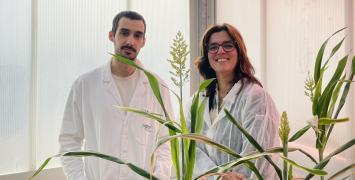Getting to the roots of better crops
Almost 842 million people worldwide are chronically undernourished according to the Food and Agriculture Organization of the United Nations (FAO). The world faces huge challenges if it is to achieve food security for a global population predicted to reach 9 billion by 2050. With ERC help, Professor Malcolm Bennett of the UK’s University of Nottingham is trying to improve crop yields through better understanding of roots and the way they grow.

To feed all, crop production needs to double, while coping with the effects of climate change – such as reduced water availability in many parts of the world – and trying to reduce the negative impacts of agricultural fertilisers.
We need food crops that produce better yields by accessing and absorbing water and nutrients more efficiently. “For 10 000 years, agriculture focused on the top half of plants,” explains Prof. Bennett. But the key to this lies underground.
Water and nitrates tend to sink deep into the soil, while phosphates are present in the topsoil near the surface. If we can choose and breed crop varieties to explore the topsoil more efficiently, and send their roots deeper, then we will be able to produce more food and reduce the amount of fertilisers needed.
It’s a kind of “engineering problem”, but to solve it we need to understand the genes that regulate root traits such as angle, depth and density.
Studying the root system – the “hidden half” – is much more complicated than studying the aerial part of a plant. They can be grown under artificial conditions in the lab, or dug up from the soil, but in a living plant the roots are underground and difficult to access. “The FUTUREROOTS project aims to improve the technology to measure and analyse these root architectures,” says Prof. Bennett.
Recently, scientists have been able to image living roots non-invasively while still growing in the soil. X-ray Computed Tomography (CT) is better known as a medical scanning technique, producing images of the inside of the human body. Advances in the technology mean it can now be used to study the finest of root hairs.
“But up to now we could only CT-scan small soil volumes,” according to the professor, “say, the size of a coffee cup, which is not enough for studying the deep roots of crop plants.”
X-ray vision
The solution came from advances in CT-scanner technology in the aviation industry: a room-sized scanner, used to inspect engine and wing parts, can look at soil samples 1 metre in length, 0.25 metres in diameter and weighing up to 80 kg.
“Funding from the European Research Council, the Wolfson Foundation and the University of Nottingham has enabled us to establish a unique root imaging platform, the Hounsfield Facility,” says Prof. Bennett. The ERC grant has paid for the new x-ray scanning equipment, capable of producing 3D images of the entire root networks of plants as they grow in soil in a state-of-the-art, fully automated greenhouse.
“The building was completed in July, just 12 months after the project was launched,” he continues. “The instruments arrive this autumn and will be operational in January.”
A deep-rooted problem
Soil is heterogeneous, 3D and complex – with water and nutrients spread around the volume. A CT scanner can show the water, soil and roots – but it does this by producing a series of “slices” of soil, x-ray cross-section images that show each root only as a tiny spot where it passes through the slice.
“The challenge is to reconstruct the roots from these cross-sections,” explains Prof. Bennett. “We have been able to adapt ‘object-tracking’ techniques – an approach employed by the security industry for finding suspects as they move through crowds – to recognise and follow each root branch and allow us to ‘peel away’ the soil.”
Prof. Bennett is also the Director of the Centre for Plant Integrative Biology (CPIB) at the University of Nottingham, an inter-disciplinary centre bringing together mathematicians, engineers and computer scientists, as well as plant and soil scientists.
“This multidisciplinary environment has really opened us up to different influences – it’s a fantastic mixing pot,” he says. “We need to work with every discipline, from software engineers to plant biologists, to address this challenging project. There are 20 of us in the ERC research team– with six PhD students co-funded by the ERC and the university.”
The centre is working with many International groups including the Institut de recherche pour le développement (IRD) in Montpellier, France, and Professor Jonathan Lynch in the US – pioneer of the ‘second green revolution’. The object is to produce better crops for both Europe and developing countries.
“We are also discovering novel mechanisms for how roots search for water,” Prof. Bennett concludes. “And, if this helps us generate new varieties of crop plants, giving higher yields in difficult conditions and more efficient in their use of soil nutrients, it will have a real agronomic impact.”






